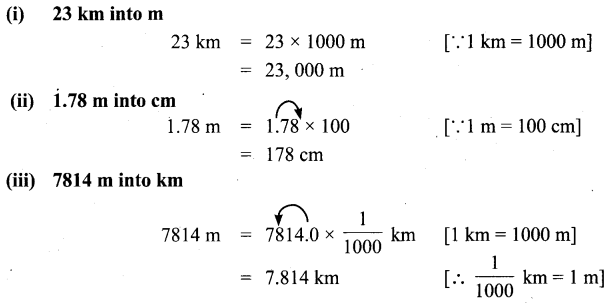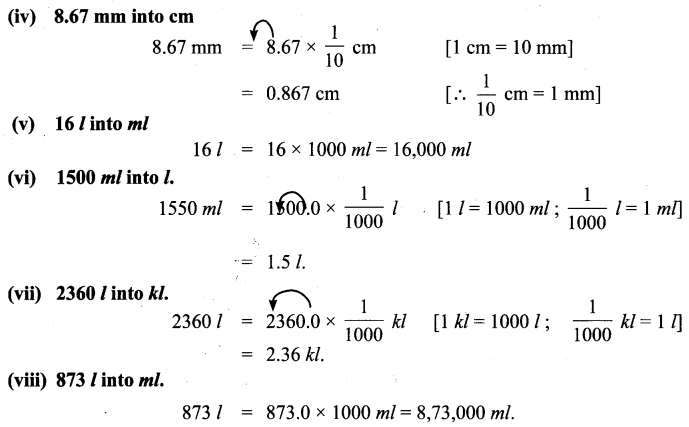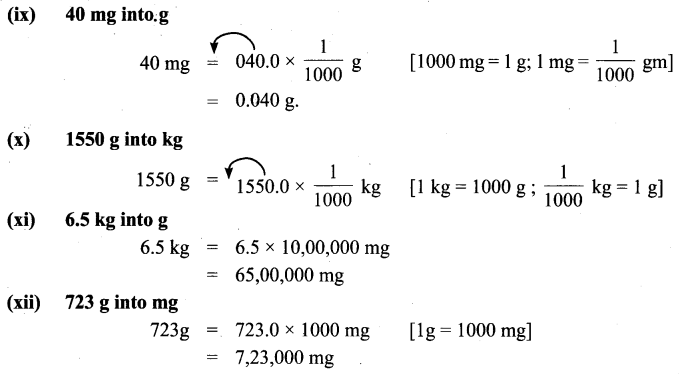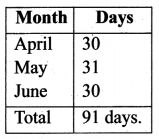You can Download Samacheer Kalvi 6th Maths Book Solutions Guide Pdf, Tamilnadu State Board help you to revise the complete Syllabus and score more marks in your examinations.
![]()
Tamilnadu Samacheer Kalvi 6th Maths Solutions Term 2 Chapter 2 Measurements Intext Questions
Try These (Textbook Page No. 26)
Question 1.
Complete the following table:

Solution:

Question 2.
Determine which metric unit you would use to express the following:
- The length of your middle finger.
- The weight of an elephant.
- The weight of the ring.
- The weight of the tablet.
- The length of the safety pin.
- The height of the building.
- The length of the seashore in Tamilnadu.
- The volume of a cup of coffee.
- The capacity of water in the tank.
Solution:
- Cm
- Kilogram
- gram
- milligram
- millimetre
- metre
- Kilometre
- Millilitre
- Litre
![]()
Try These (Textbook Page No. 28)
Question 1.
Convert the following.
(i) 23 km into m
(ii) 1.78 m into cm
(iii) 7814 m into km
(iv) 8.67 mm into cm
(v) 16 l into ml
(vi) 1500 ml into l
(vii) 2360 l into kl
(viii) 873 l into ml
(ix) 40 mg into g
(x) 1550 g into kg
(xi) 6.5 kg into g
(xii) 723 g into mg
Solution:



Try These (Textbook Page No. 30)
Question 1.
Five kilograms of compost is needed for a coconut tree for every six months. How many kilograms of compost is needed for 50 such coconut trees for one and a half years?
Solution:
Compost needed for a tree for 6 months = 5 kg
Compost needed for 50 trees for half a year = 5 × 50 = 250 kg.
Compost needed for 1\(\frac { 1 }{ 2 }\) years = 250 × 3 = 750 kg. [∴ 1\(\frac { 1 }{ 2 }\) years = 3 half years]
Question 2.
Say True or False and Justify.
(a) Is it correct: 4 m + 3 cm = 7 m
(b) Can we add the following?
(i) 6 litre + 7 kg
(ii) 3 m + 5 l
(iii) 400 ml + 300 g
Solution:
(a) False.
4 m + 3 cm = 400 cm + 3 cm = 403 cm.
(b) (i) No, we can’t add.
(ii) No. We can’t add.
(iii) No. We can’t add.
![]()
Recap (Textbook Page No. 33)
Question 1.
Read and write the time in the appropriate place.

Solution:

Try These (Textbook Page No. 33)
Question 1.
Say the following time in two ways.
(a) 9.20
(b) 4.50
(c) 5.15
(d) 6.45
(e) 11.30
Solution:
(a) 9.20
20 minutes past 9
40 minutes to 10
(b) 4.50
50 minutes past 4
10 minutes to 5
(c) 5.15
15 minutes past 5
45 minutes to 6
(d) 6.45
45 minutes past 6
15 minutes to 7
(e) 11.30
30 minutes past 11
30 minutes to 12
Try These (Textbook Page No. 34)
Question 1.
Convert the following:
(i) 4 hours = _____ minutes
(ii) 240 minutes = ____ hours
(iii) 30 minutes = _____ seconds
(iv) 3600 seconds = _____ hours
(v) 2 hours = _____ seconds
Solution:
(i) 4 hours = 240 minutes
4 hours = 4 × 60 minutes = 240 minutes
(ii) 240 minutes = 4 hrs
240 minutes = \(\frac{240}{60}\) = 4 hrs
(iii) 30 minutes = 1800 seconds
30 minutes = 30 × 60 seconds = 1800 seconds
(iv) 3600 seconds = 1 hrs
3600 seconds = \(\frac{3600}{60}\) minutes = 60 minutes = \(\frac{60}{60}\) hours = 1 hour
(v) 2 hrs = 7200 seconds
2 hrs = 2 × 60 minutes = 120 minutes = 120 × 60 seconds = 7200 seconds
![]()
Try These (Textbook Page No. 36)
Question 1.
Convert the 12-hour format into the 24-hour format and vice versa.

Solution:
10 : 40 a.m. = 10 : 40 hours
11 a.m. = 11 : 00 hours
1 : 15 a.m. = 01 : 15 hours
5 a.m. = 05 : 00 hours
16 : 20 hours = 4 : 20 p.m.
00 : 40 hours = 12 :40 a.m.
1 p.m. = 13 : 00 hours
11 : 15 p.m. = 23 : 15 hours
3 p.m. = 15 :00 hours
12 midnight = 00 : 00 hours
12 : 25 hrs = 00 : 25 p.m.
4 : 10hrs = 4 : 10 a.m.
Try These (Textbook Page No. 39)
Question 1.
Check whether the following years as Ordinary or Leap Year?
1994; 1985; 2000; 2007; 2010; 2100
Solution:
We know that a leap year is divisible by 4.
In the case of a century which is divisible by 400 is a leap year.
1994 – Not a leap year (Not divisible by 4)
1985 – Not a leap year (Not divisible by 4)
2000 – It is a leap year (divisible by 400)
2007 – Not a leap year (Not divisible by 4)
2010 – Not a leap year (Not divisible by 4)
2100 – Not a leap year (Not divisible by 400)
Question 2.
How many days are there from 1st April to 30th June?
Solution:
Months from April to June are:
